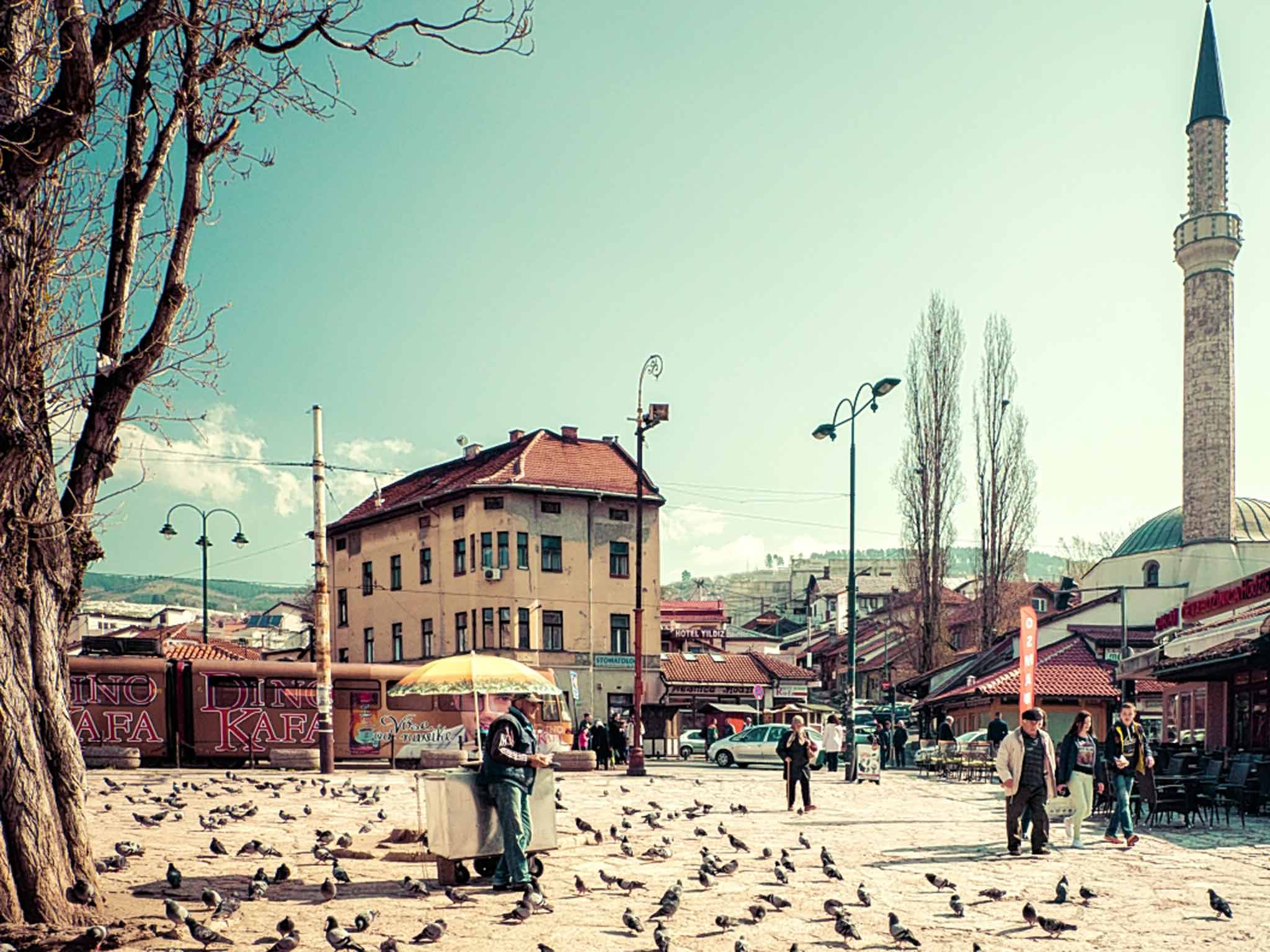The Independent's journalism is supported by our readers. When you purchase through links on our site, we may earn commission.
Sarajevo 20 years after the war: Building a better Bosnia
Two decades after the Balkan War ended, this city is rising above its bloody past, says Anthea Gerrie

The first thing that strikes me is the sylvan topography – high mountains either side of a lush green city bisected by a river. Then the east-meets -west architecture, the rich legacy of two great empires, the Ottoman and the Austro-Hungarian, which renders Sarajevo one of Europe's most beguiling capitals.
But within a heartbeat I notice the bullet holes pockmarking Baroque mansions. They also puncture the Tito-era tower blocks; with their patchwork of mismatched doors and windows salvaged for DIY repairs, these are a striking testimony to the resilience of a people targeted for extermination just 20 years ago. Sarajevo's tragic history, which dates back far longer than Bosnia's civil war, is laid bare upon the bones of its exquisite natural beauty and fine architecture that neither bombs nor snipers could manage to eradicate in four years of bloody conflict.
Sarajevo may be looking forward, with its new, futuristic glass palaces of commerce, but it is still stained by its bloody history. Had Archduke Franz Ferdinand not suddenly changed the route of his state procession through the city in 1914, the city would not have become infamous as the starting line of the First World War. The Latin Bridge, beside which he was assassinated, is now the city's most renowned landmark. It's one of 38 beautiful bridges that traverse the tranquil Miljacka, each one marking a different era in the city's history from the 16th-century Latin and Goat's bridges, built by the Ottomans, to the striking loops of the 2012 Festina lente pedestrian bridge designed by students of the Academy of Fine Arts.
Sarajevo enjoyed its first golden age under the Ottomans in the 16th and 17th centuries, and their huge oriental bazaar, Bascarsija, remains the city's greatest attraction. Bustling cafés serve the city's favourite snack, cevapi – grilled lamb sausages packed into charred flatbread with soft sheep's milk cheese. In the surrounding old city, impressive mosques stand side by side with Orthodox and Catholic cathedrals and a 1581 synagogue – a reminder of the religious tolerance which flourished here for centuries.
While day-trippers from neighbouring countries come simply to shop for Ottoman-style slippers and copperware, admire the imposing Habsburg-era city hall, and enjoy good coffee and shisha pipes, inevitably the 1992-95 siege has spawned a new breed of tourist. Sarajevo's second most popular attraction is the remnants of the tunnel beneath the airport runway. Dug secretly, this lifeline provided the means to transport a supply of arms, food and essentials to the besieged city-dwellers.
Visiting the tunnel museum is a slightly sanitised experience, but meeting siege survivors in their homes and hearing their personal war stories over dinner is truly haunting. It's an option offered by Insight Vacations, one of only a small handful of tour operators offering trips to Bosnia.
Inside one of those bullet-riddled tower blocks which line the long corridor between the city centre and airport – the focus of four years of sustained attack – my 35-year-old hostess, Sanela, recalled having to run eight floors down to the basement shelter on a daily basis during the conflict. Eventually, she persuaded her mother to let her out to play, just for half an hour, with her best friend. A grenade exploded moments after they revelled in their first breath of fresh air in months, killing her friend. They were 11. Further heartbreak came when the teacher who came to give the children school work was killed by a sniper. Later, Sanela's mother risked her life to walk for two hours into Sarajevo city centre for a litre of milk for the baby. On her way back, she too was cruelly picked out by a sniper.
A surge of rebuilding has taken place over the past decade, but the tower blocks are a bizarre patchwork of window sashes borrowed from here, doors taken from there, quite at odds with the new, sleek glass buildings which speak to an optimism for the future. Stylish, modern hotels such as the offbeat, antique-studded Michele, which has hosted Kevin Spacey and Morgan Freeman; and the sleek, bright Colors Inn are also emerging as Sarajevo realises its strong tourism potential could be the economic salvation needed to overcome rampant unemployment.
These new, modern additions to Sarajevo's majestic heritage buildings and exquisite natural setting mean that the city won't be a secret among weekend breakers for long. The Sarajevo Film Festival will attract big names next month, and the city has every chance of recapturing the reputation for international hospitality it demonstrated in 1984 as the host of the Winter Olympics. There is no doubt that this wonderful city fully deserves to be back on the tourist map.
Getting there
Anthea Gerrie travelled to Bosnia-Herzegovina and Croatia with Insight Vacations (0800 533 5625; insightvacations.com), which offers trips to Sarajevo as part of its escorted group tours of the Balkans.
A 15-day Imperial Capitals & The Dalmatian Riviera trip costs from £2,550 per person. The price includes return flights from London, door-to-door airport transfers, accommodation with breakfast, six evening meals, sightseeing and the services of a tour director.
More information
Bosnia-Herzegovina Tourism: bhtourism.ba
Subscribe to Independent Premium to bookmark this article
Want to bookmark your favourite articles and stories to read or reference later? Start your Independent Premium subscription today.

Join our commenting forum
Join thought-provoking conversations, follow other Independent readers and see their replies